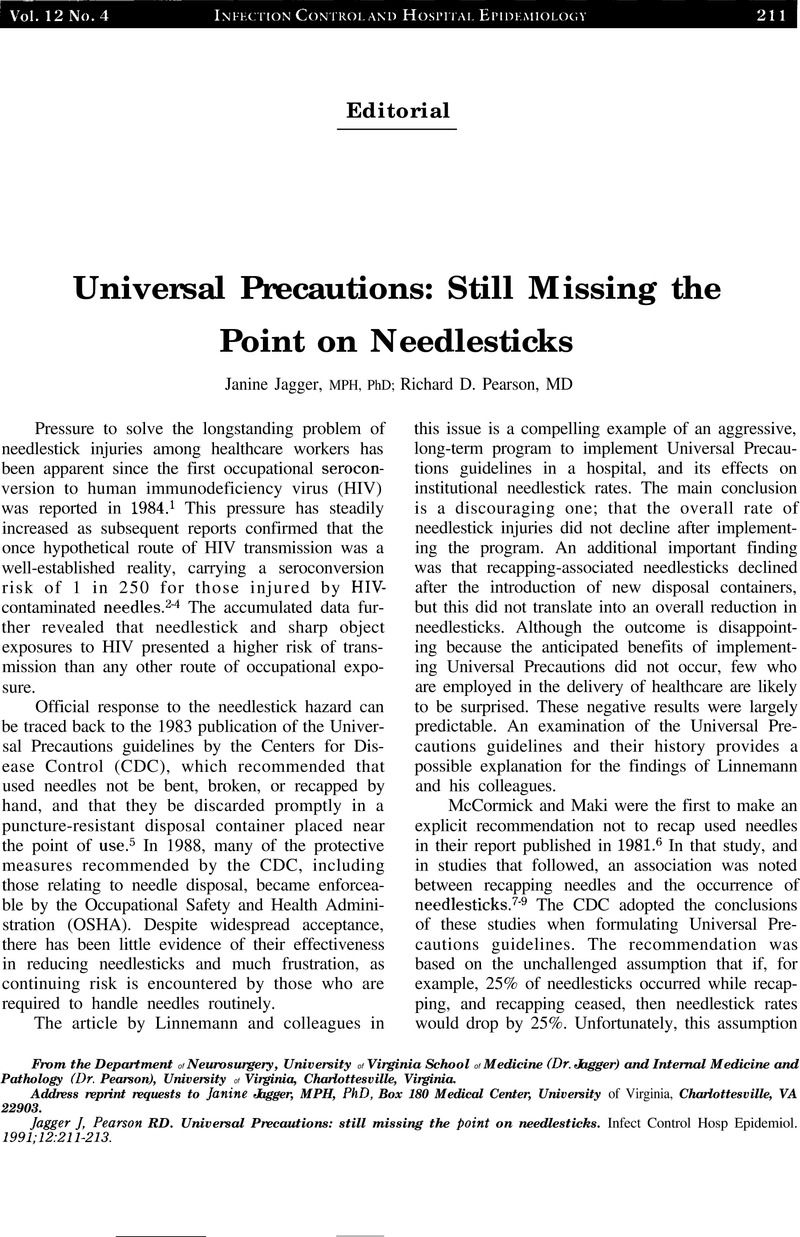Crossref Citations
This article has been cited by the following publications. This list is generated based on data provided by Crossref.
Weber, T.
Hunsmann, G.
Stevens, W.
and
Fleming, A.F.
1992.
Human retroviruses.
Baillière's Clinical Haematology,
Vol. 5,
Issue. 2,
p.
273.
Cusini, Marco
and
Zerboni, Roberto
1992.
AIDS in the workplace.
Clinics in Dermatology,
Vol. 10,
Issue. 2,
p.
201.
Backinger, Cathy L.
and
Koustenis, George H.
1994.
Analysis of needlestick injuries to health care workers prhome care.
American Journal of Infection Control,
Vol. 22,
Issue. 5,
p.
300.
Beekmann, Susan E.
and
Henderson, David K.
1995.
HIV Infection in healthcare workers: Risk for infection and methods of prevention.
Seminars in Dermatology,
Vol. 14,
Issue. 3,
p.
212.
Petrosillo, N.
Puro, V.
Ippolito, G.
Nardo, V.Di
Albertoni, F.
Chiaretti, B.
Rava', L.
Sommella, L.
Ricci, C.
Zullo, G.
Bonaventura, M.E.
Galli, C.
and
Girardi, E.
1995.
Hepatitis B virus, hepatitis C virus and human immunodeficiency virus infection in health care workers: a multiple regression analysis of risk factors.
Journal of Hospital Infection,
Vol. 30,
Issue. 4,
p.
273.
Tereskerz, Patricia M.
Pearson, Richard D.
and
Jagger, Janine
1996.
Occupational Exposure to Blood among Medical Students.
New England Journal of Medicine,
Vol. 335,
Issue. 15,
p.
1150.
Lawrence, Louann W.
Delclos, George L.
Felknor, Sarah A.
Johnson, Philip C.
Frankowski, Ralph F.
Cooper, Sharon P.
and
Davidson, Anthony
1997.
The Effectiveness of a Needleless Intravenous Connection System An Assessment by Injury Rate and User Satisfaction.
Infection Control & Hospital Epidemiology,
Vol. 18,
Issue. 3,
p.
175.
Weiss, Stanley H.
1997.
RISKS AND ISSUES FOR THE HEALTH CARE WORKER IN THE HUMAN IMMUNODEFICIENCY VIRUS ERA.
Medical Clinics of North America,
Vol. 81,
Issue. 2,
p.
555.
Arduino, Matthew J.
Bland, Lee A.
Danzig, Lisa E.
McAllister, Sigrid K.
and
Aguero, Sonia M.
1997.
Microbiologic evaluation of needleless and needle-access devices.
American Journal of Infection Control,
Vol. 25,
Issue. 5,
p.
377.
Hanrahan, Anita
and
Reutter, Linda
1997.
A Critical review of the literature on sharps injuries: epidemiology, management of exposures and prevention.
Journal of Advanced Nursing,
Vol. 25,
Issue. 1,
p.
144.
Jahan, Saulat
2005.
Epidemiology of needlestick injuries among health care workers in a secondary care hospital in Saudi Arabia.
Annals of Saudi Medicine,
Vol. 25,
Issue. 3,
p.
233.
Chen, Guang X.
and
Jenkins, E. Lynn
2007.
Potential work‐related bloodborne pathogen exposures by industry and occupation in the United States Part I: An emergency department‐based surveillance study.
American Journal of Industrial Medicine,
Vol. 50,
Issue. 3,
p.
183.
Askari, Elaine
and
DeBaun, Barbara
2009.
Handbook of Modern Hospital Safety, Second Edition.
p.
1.



